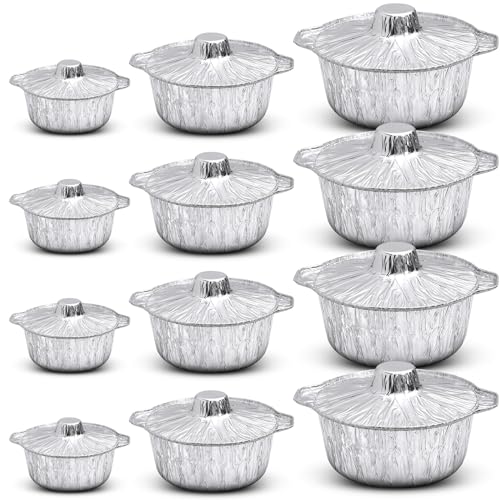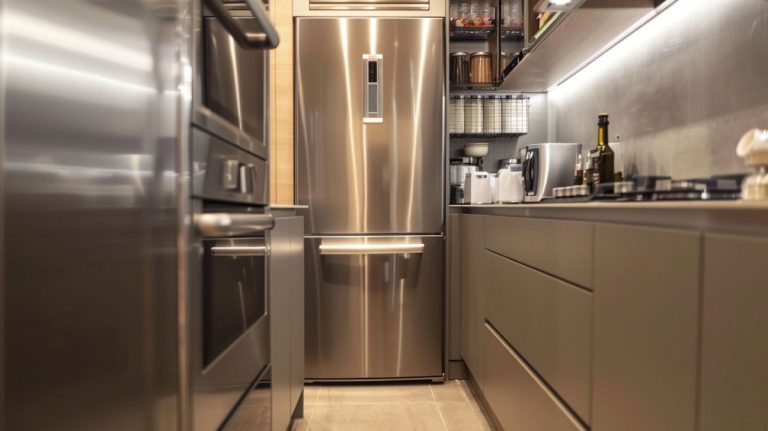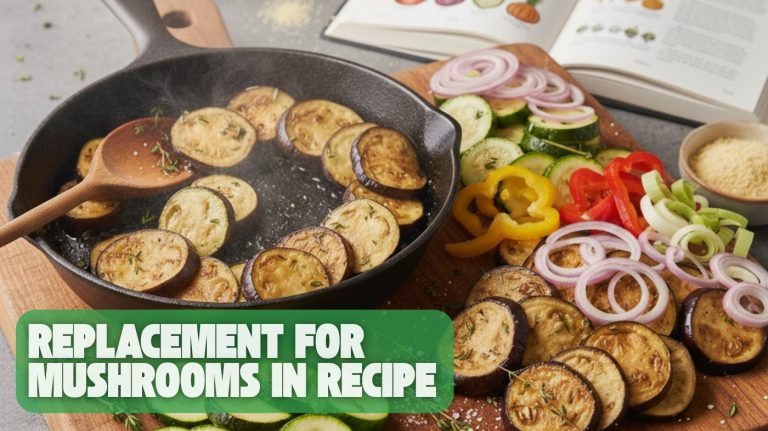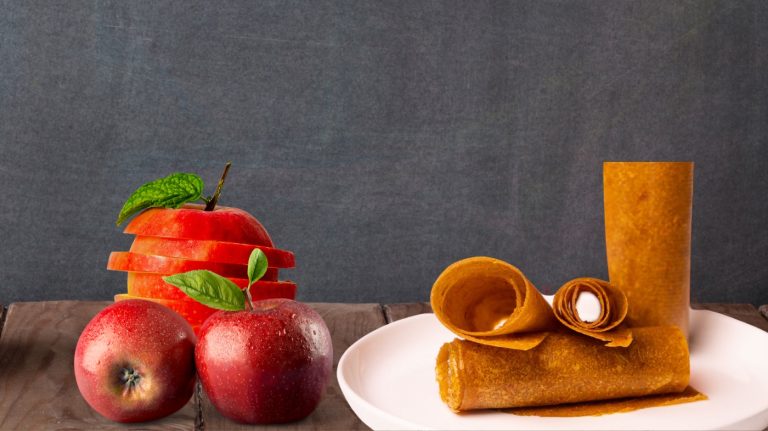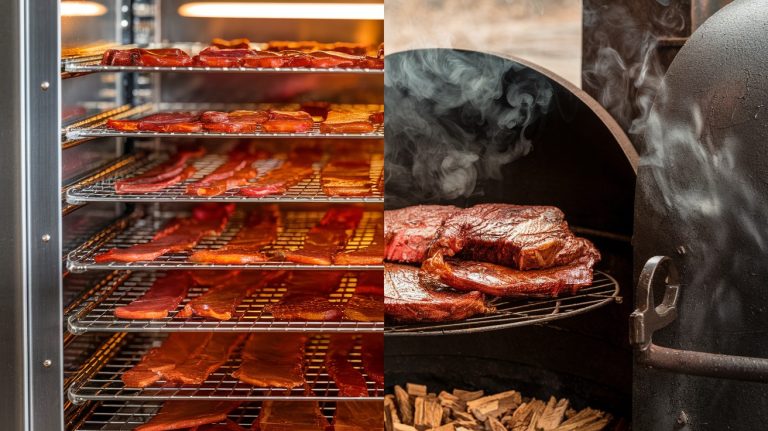Aluminum vs Stainless Steel Pots: Which Heats Better?
You’ll find aluminum pots heat faster and distribute heat more evenly than stainless steel, making them efficient for quick cooking. However, they’re lighter and less durable.
Stainless steel pots are heavier, resist warping, and handle high heat well. They offer excellent longevity and food safety by preventing metal leaching, especially with acidic dishes.
While aluminum costs less upfront, stainless steel’s durability often proves more economical long term. If you want to optimize your cookware choice, understanding these trade-offs matters.
- ✅ Durable & Efficient Cast Aluminum Caldero – Perfect for Everyday Cooking: Designed for home…
- 🍚 Ideal Size for Families – Cooks Up to 18 Servings of Rice: Whether you’re making a hearty…
- 🔥 Fast-Heating Deep Fryer for Crispy, Juicy Results: The quick-heating aluminum design ensures…
- Stainless steel and 5 layers bottom: Kirecoo 8-Quart Stainless Steel Stockpot with Lid is an…
- Riveted handles and Glass lid: Kirecoo soup pot comes equipped with riveted stainless steel side…
- Versatility with Large Size: Kirecoo 8 qt cooking pot features classic sliver appearance and large…
Key Takeaways
- Aluminum pots heat faster and distribute heat more evenly than stainless steel, ideal for quick cooking and boiling tasks.
- Stainless steel pots are more durable, resistant to rust, dents, and corrosion, and maintain appearance over extended use.
- Aluminum cookware is lighter and easier to handle but prone to warping and surface wear with frequent use.
- Stainless steel is safer for acidic foods due to inert properties, while aluminum may leach metals unless anodized.
- Aluminum pots are more budget-friendly but less long-lasting compared to higher-cost, longer-lasting stainless steel pots.
Quick Comparison Table for Aluminum and Stainless Steel Pots
| Feature | Aluminum Pots | Stainless Steel Pots |
|---|---|---|
| Heat Conductivity | Excellent – Heats quickly and evenly, ideal for fast cooking. | Moderate – Slower heating, but consistent with layered cores. |
| Weight & Handling | Lightweight – Easy to lift, carry, and store. | Heavier – More stable but harder to maneuver. |
| Durability | Softer Material – Can warp or scratch easily. | Highly Durable – Resists dents, rust, and high heat. |
| Maintenance | Needs Gentle Care – Hand-wash recommended; avoid harsh detergents. | Low Maintenance – Dishwasher-safe and easy to clean. |
| Food Safety | Reactive with acidic foods unless anodized. | Non-Reactive – Safe for all ingredients. |
| Longevity | Shorter Lifespan – May need replacement sooner. | Long-Term Investment – Retains quality for years. |
| Aesthetic Appeal | Matte/Anodized Finish – Available in colors. | Polished Metal Look – Professional and elegant. |
| Cost | Budget-Friendly – Lower initial price. | Higher Upfront Cost – Balanced by extended use. |
Heat Conductivity and Cooking Efficiency
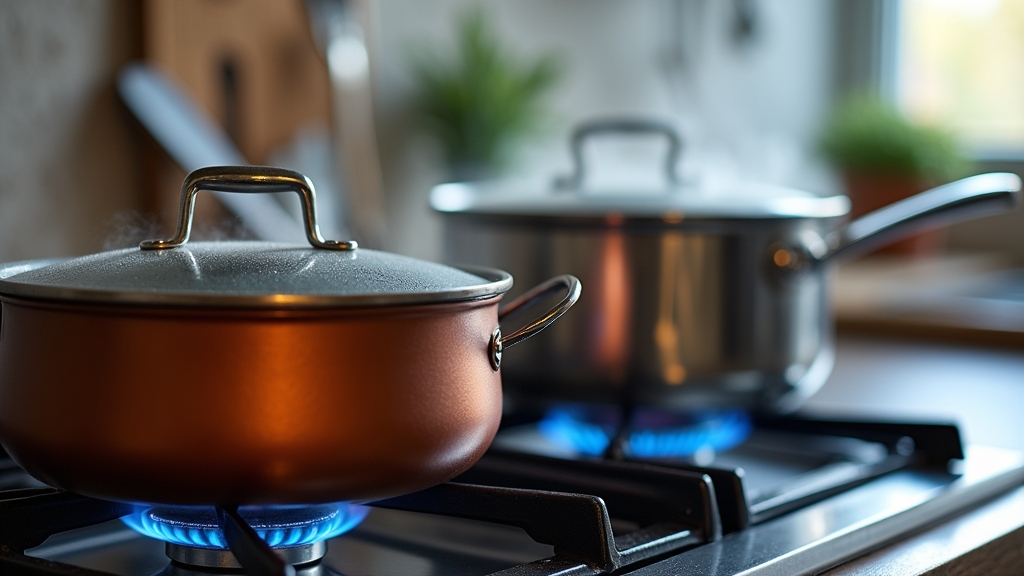
Although stainless steel offers durability, aluminum outperforms it in heat conductivity, with values around 205-235 W/(m/K) compared to stainless steel’s 15-45 W/(m/K).
Aluminum’s heat conductivity far exceeds stainless steel, enabling faster and more even cooking.
This significant difference allows aluminum pots to heat up rapidly and distribute heat evenly, minimizing hotspots and ensuring uniform cooking.
You’ll find aluminum’s high thermal conductivity advantageous for precise temperature control, which is critical when preparing delicate dishes like sauces or seafood.
Stainless steel cookware often compensates for its lower conductivity by integrating an aluminum core, enhancing heat distribution without compromising durability.
Aluminum’s quick heating capability supports efficient cooking, especially for high-volume tasks like boiling.
Additionally, aluminum’s lightweight design makes it easy to handle during cooking, especially in busy or outdoor environments.
In contrast, stainless steel’s slower, less uniform heating may impact cooking speed but contributes to robustness and corrosion resistance. This makes stainless steel better suited for long-term durability in cookware.
Weight and Ease of Handling
When handling cookware, weight plays a critical role in your overall ease and efficiency.
Aluminum pots typically weigh about one-third less than stainless steel, averaging around 1 kg versus 1.5 kg or more.
This significant weight difference makes aluminum easier to lift, carry, and maneuver, especially when handling large or full pots.
You’ll find aluminum advantageous during prolonged cooking sessions or when portability is essential, such as outdoor cooking.
Conversely, stainless steel’s heavier mass offers superior stability on the stove, reducing the risk of tipping.
However, this weight increases fatigue and handling effort, particularly when moving filled pots.
For storage, aluminum’s lighter weight allows easier stacking and rearranging, minimizing strain and cabinet damage.
Stainless steel’s bulk may limit convenience despite its robustness.
Additionally, aluminum cookware is generally more affordable, providing both weight and cost advantages that enhance its appeal.
Longevity and Maintenance Requirements
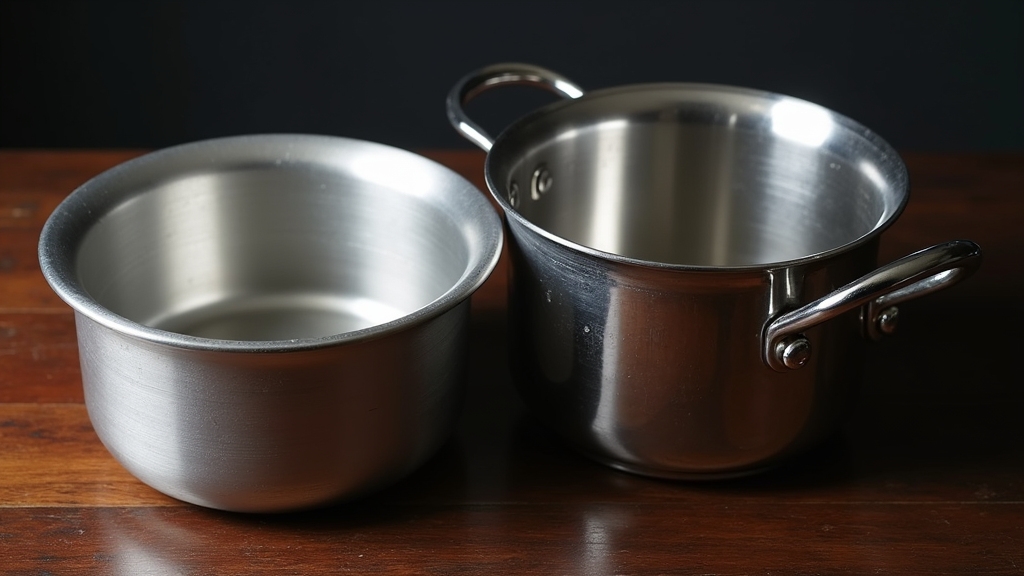
Beyond weight and handling, the durability and upkeep of cookware considerably influence its long-term value and performance.
Stainless steel pots, especially grades 304 and 316, withstand scratches, dents, warping, and corrosion, ensuring extended longevity. They tolerate high heat without deforming and require routine cleaning with mild detergents, plus occasional deep cleaning to maintain their finish. Stainless steel’s durability makes it suitable for long-term, heavy-duty kitchen use. Additionally, stainless steel utensils, such as metal spatulas, are ideal for use with stainless steel cookware due to their durability and heat resistance.
Grades 304 and 316 stainless steel resist damage and corrosion, offering exceptional durability for cookware.
Aluminum cookware, being softer, is more prone to surface damage and deformation, particularly under high heat. Hard-anodized aluminum improves durability but still falls short of stainless steel’s lifespan. Aluminum demands prompt, gentle cleaning to avoid stains and corrosion, especially from acidic foods. Non-stick coatings degrade over time.
Food Safety and Material Reactivity
Because cookware materials directly contact food, understanding their safety and chemical reactivity is crucial for both health and culinary outcomes. Aluminum cookware, especially uncoated or low-grade, can leach aluminum ions when exposed to acidic foods like tomato sauce, potentially impacting health and altering taste.
Hard-anodized aluminum mitigates this by forming a stable oxide layer, reducing metal transfer. However, aluminum is also known for its excellent heat conduction, spreading heat quickly and evenly, which benefits cooking performance. Proper maintenance and cleaning can preserve cookware integrity and performance.
Stainless steel, containing over 10.5% chromium, develops a protective oxide barrier that resists corrosion and leaching. Although trace nickel and chromium may release initially, they stabilize with use. Stainless steel‘s inertness preserves food flavor and safety, making it suitable for acidic or alkaline dishes. You should consider nickel allergies with stainless steel and avoid low-quality aluminum to minimize metal exposure risks and maintain ideal food integrity. Its durability and resistance to stains and corrosion make it a practical choice for long-term use.
Cost Comparison and Value Over Time
Although aluminum pots come with a considerably lower upfront cost, often 30-70% less than comparable stainless steel cookware, you should weigh this against factors like durability and maintenance. Aluminum’s affordability suits budget buyers and portable use, but its susceptibility to dents, warping, and coating degradation means more frequent replacements. Additionally, aluminum can react with acidic foods, which may affect both the pot and the flavor.
Stainless steel, despite higher initial prices, offers superior scratch and corrosion resistance, extending its lifespan and reducing long-term expenses. Its construction often includes layers of aluminum or copper that enhance heat conduction and cooking performance. Stainless steel’s non-reactive surface ensures consistent flavor and easier cleaning, making it preferable for a variety of cooking methods.
Consider these points when evaluating cost and value over time:
Aluminum demands careful upkeep to avoid damage and possible reactivity, increasing maintenance effort. Stainless steel’s durability and ease of cleaning lower indirect costs and replacement frequency. Investing in mid-range tri-ply stainless steel balances upfront cost with longevity and heat conduction performance benefits.
Aesthetic Appeal and Heat Durability
When choosing between aluminum and stainless steel pots, you’ll notice distinct differences in both aesthetic appeal and heat durability that influence their performance and longevity.
Aluminum’s anodized finish offers varied colors and a matte sheen but scratches easily. Stainless steel boasts a polished, reflective surface that resists corrosion and maintains elegance. Its corrosion resistance makes it suitable for hygiene-critical environments such as kitchens.
Heat durability favors stainless steel, which withstands high temperatures without warping. In contrast, aluminum requires careful temperature control. Additionally, stainless steel pots are known for their durability and resistance to rust and dents, making them ideal for heavy-duty use.
| Feature | Aluminum Pot | Stainless Steel Pot |
|---|---|---|
| Aesthetic Finish | Anodized, colorful, matte/semi-gloss | Polished/brushed, classic metallic |
| Scratch Resistance | Lower, shows wear over time | High, resists dents and corrosion |
| Heat Durability | Moderate, prone to warping | Superior, retains shape at high heat |
| Heat Conductivity | Excellent, quick even heating | Lower, improved with aluminum core |
Ideal Uses and Cooking Scenarios
Beyond their visual qualities and heat tolerance, aluminum and stainless steel pots serve distinct roles in the kitchen based on their thermal properties and durability. You’ll prefer aluminum pots for fast, even heating, which is ideal for stews or boiling, where consistent temperature matters. Aluminum cookware is also widely used because it is cost-effective. Regular maintenance and proper cleaning are essential to preserve the cookware’s performance over time.
However, aluminum’s softness makes it prone to wear, limiting its lifespan. Stainless steel excels in durability and is non-reactive, making it perfect for acidic dishes and long-term use despite slower heat response.
Consider these scenarios:
Use aluminum for time-sensitive cooking requiring rapid heat adjustments. Choose stainless steel for outdoor cooking and heavy-duty tasks due to its resilience. Opt for multi-ply stainless steel with aluminum cores to combine heat performance and durability.
This technical distinction helps you select cookware optimized for specific cooking demands. Proper upkeep and maintenance techniques can significantly extend the life of both aluminum and stainless steel pots.
Frequently Asked Questions
Can Aluminum or Stainless Steel Pots Be Used on Induction Cooktops?
You can use stainless steel pots on induction cooktops if they’re magnetic, as most are.
Aluminum pots won’t work unless they’ve a special magnetic base, since aluminum itself isn’t magnetic and won’t generate heat on induction surfaces.
To verify compatibility, check if your cookware attracts a magnet.
Opt for stainless steel or cast iron for reliable induction cooking, as they provide efficient heat transfer and durability.
Are Aluminum or Stainless Steel Pots Dishwasher Safe?
When it comes to dishwasher safety, stainless steel pots are your reliable workhorses. They withstand heat, detergents, and corrosion without fuss.
Aluminum pots, however, aren’t cut out for dishwasher cycles. Harsh detergents and heat strip their protective layer, causing discoloration and pitting.
You should hand wash aluminum to preserve its surface and lifespan. Always check manufacturer guidelines, since some anodized or treated aluminum variants might tolerate dishwashers, but that’s the exception, not the rule.
How Do Aluminum and Stainless Steel Pots Affect Microwave Cooking?
You shouldn’t use aluminum or stainless steel pots in the microwave because both metals reflect microwaves. This prevents proper heating of your food.
This reflection can cause sparks, arcing, or even fire hazards, risking damage to your microwave’s components. Metals block microwave radiation, leading to uneven or no heating.
Instead, use microwave-safe glass or ceramic cookware to guarantee safe, efficient heating and avoid appliance malfunction or safety issues.
Do Aluminum or Stainless Steel Pots Retain Odors From Previous Meals?
You won’t believe how stainless steel pots completely refuse to harbor odors. They’re like a fortress against lingering smells.
Their non-porous, smooth surfaces prevent any absorption, ensuring your next meal tastes pure.
Aluminum pots, however, can trap and transfer odors, especially if untreated or stained. This is due to their reactive and porous nature.
Even thorough cleaning struggles to fully eliminate these residues, making stainless steel the superior choice for odor-free cooking.
Which Pot Material Is Better for Freezing or Storing Food?
You’ll find stainless steel pots superior for freezing and storing food due to their non-reactive nature, preventing flavor alterations and chemical leaching.
They resist corrosion, scratches, and warping, maintaining container integrity over time.
Although aluminum freezes food faster thanks to better thermal conductivity, its susceptibility to corrosion and coating degradation makes it less reliable.
Stainless steel’s durability and hygienic cleaning ease guarantee safer, longer-term food storage in cold environments.
Ready to Upgrade Your Cookware? Choose Smart, Cook Better
When choosing between aluminum and stainless steel pots, consider your cooking style and priorities. Aluminum heats quickly and evenly, ideal for sautéing vegetables fast, but it’s softer and requires careful maintenance.
Stainless steel offers durability and non-reactivity, perfect for simmering acidic dishes like tomato sauce without flavor alteration.
For example, a busy chef might prefer stainless steel for longevity despite higher cost, while a home cook favors aluminum’s efficiency and lighter weight for everyday meals.
- Abundant Inclusion in the Package: the package includes 12 disposable aluminum pots accompanied by…
- Disposable yet Durable: our food containers are a useful tool for those who want an easily cooking…
- Durable for Reuse: these tinfoil pots are disposable, makes them a good addition to your kitchen;…
- Large capacity: holds up to 8 quarts–great for large batches of soups, stews, and more
- Sturdy and fast heating: made of heavy-gauge stainless steel for reliable strength;…
- Riveted handles and glass lid: stainless-steel side handles come riveted for strength; transparent…
Last update on 2025-11-28 / Affiliate links / Images from Amazon Product Advertising API




